
The Southern Railway (SR) gave the designations 4-COR, 4-RES, 4-BUF and 4-GRI to the different types of electric multiple unit built to work the route between London Waterloo and Portsmouth Harbour. The 4-COR type units survived long enough in British Rail ownership to be allocated TOPS Class 404. The COR designation had previously been used for the 6-PUL units and was reused by them during World War II when the Pullman car was stored, but this stock was different from the 4-COR units.
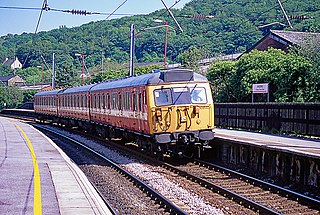
The British Rail Class 308 alternating current (AC) electric multiple units (EMU) were built by British Railways' Holgate Road carriage works in three batches between 1959 and 1961. They were initially classified as AM8 units before the introduction of TOPS.

The British Rail Class 377 Electrostar is a British dual-voltage electric multiple unit passenger train (EMU) built by Bombardier Transportation on its Electrostar platform at Derby Litchurch Lane Works from 2001 to 2014.
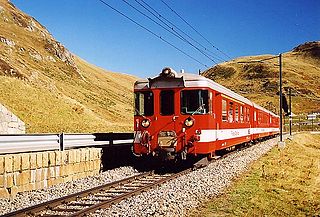
The Furka Oberalp Railway is a narrow gauge mountain railway in Switzerland with a gauge of 1,000 mm. It runs in the Graubünden, Uri and Canton of Valais. Since January 1, 2003, it is part of the Matterhorn Gotthard Bahn when it merged with the BVZ Zermatt-Bahn.
The Southern Railway (SR) gave the designations 6 PUL, 6 CITY and 6 PAN to electric multiple units built to work the routes between London and Brighton, West Worthing and Eastbourne. None of these units survived long enough in British Rail ownership to be allocated a TOPS class number. The 6 PUL units were designated 6 COR until 1935.

The Southern Railway (SR) gave the designation 2-BIL to the DC third rail electric multiple units built during the 1930s to work long-distance semi-fast services on the newly electrified lines from London to Eastbourne, Portsmouth and Reading. This type of unit survived long enough in British Rail ownership to be allocated TOPS Class 401.

The Southern Railway (SR) gave the designation 4-LAV to the electric multiple units built to work the semi-fast services on the route between London and Brighton. None of these units survived long enough in British Rail ownership to be allocated a TOPS class.

The Southern Railway (SR) in the UK gave the designation SL to the fleet of AC overhead electric multiple units used on the South London Line between Victoria and London Bridge station. These had been built by the London, Brighton and South Coast Railway in 1909, but with the abandonment of the Elevated Electric service in 1928 they were converted to DC third rail units.
The Southern Railway (SR) gave the designation CP to the fleet of AC electric multiple units used on the former London, Brighton and South Coast Railway lines in the Crystal Palace area.
The Lancashire and Yorkshire Railway (LYR) built suburban electric stock for lines in Liverpool and Manchester. The line between Liverpool to Southport began using electric multiple units (EMUs) on 22 March 1904, using a third rail 625 V DC. Additional trains were later built for this route, and in 1913 incompatible stock for the route to Ormskirk. Lightweight units were built to run on the Liverpool Overhead Railway.

The British Rail Class 310 was a slam-door, alternating current (AC) electric multiple unit (EMU) introduced in 1965 as part of the West Coast Main Line electrification project. They were initially classified as Class AM10 units before the introduction of the TOPS classification system. Constructed at BR's Derby Carriage and Wagon Works. They consisted of four carriages - a second class driving trailer, a second class trailer, a second class motor car and a composite driving trailer. The maximum speed was 75 miles per hour (121 km/h). A glass partition behind the driver's cab enabled passengers in the leading and rear coaches to view the line ahead or behind.

An electric multiple unit (EMU) is an electric self-powered train, capable of operating in multiple with other EMUs and without the need for a locomotive; these are typically passenger trains with accommodation in every vehicle and a driving position at each end. The term can also be used to describe a train that is a permanent formation with a non-driving power car, such as the Advanced Passenger Train. As of December 2010, two-thirds of the passenger carriages in Great Britain are formed in EMUs.

The British Rail Class 501 electric multiple units were built in 1955/56 for use on the former LNWR/LMS suburban electric network of the London Midland Region. A total of 57 three-car units were built.
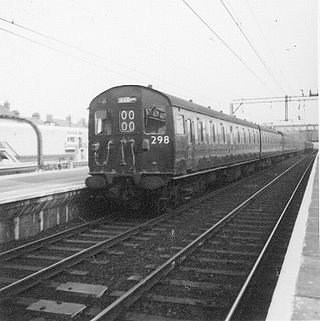
The British Rail Class 302 was a type of electric multiple unit (EMU) introduced between 1958 and 1960 for outer suburban passenger services on the London, Tilbury and Southend line. This class of multiple unit was constructed using the Mark 1 bodyshell and was slam-door.
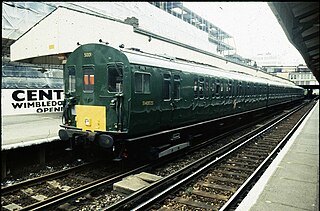
The British Rail Class 415 was a suburban 750 V DC third rail electric multiple unit commissioned by the Southern Region of British Railways. Built between 1951 and 1957, it became the most numerous class on the region after the withdrawal of the 4SUBs. The final trains were withdrawn in the 1990s, replaced by Class 455, 456, 465 and 466.

The LNER electric units were electric multiple units that ran on the Tyneside Electrics, a suburban system around the English city of Newcastle upon Tyne. In 1937 the London and North Eastern Railway (LNER) received articulated twin passenger electric units to replace the NER electric units that had been built in 1904–15 by the North Eastern Railway. The order including some single-unit motor parcel vans and motor luggage vans. In the 1960s declining passenger numbers and the high cost of renewing life-expired electric substation equipment across the system led to the replacement of the electric multiple units with diesel multiple units and the units were all withdrawn in 1967.

The Alstom Coradia Juniper series is a family of electric multiple unit trains built by Alstom Transport Birmingham for use on the railway network in Great Britain. The family is related to the Coradia 1000 series of diesel multiple units.
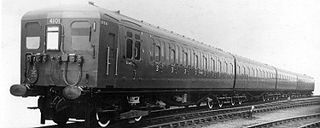
The Southern Railway (SR) and the British Railways used the designation Sub to cover a wide variety of electric multiple-unit passenger trains that were used on inner-suburban workings in the South London area. The designation 'Sub' was first officially used in 1941 to refer to newly built 4-car units. However, during the 1940s large numbers of earlier '3-Car Suburban Sets' were increased to four cars by the addition of an 'Augmentation' trailer, and became part of the 4-Sub category. The SR and BR (S) continued to build or else rebuild 4-car units to slightly different designs which became part of the 4-Sub Class. Many of these later examples survived in passenger use until late 1983, by which time British Rail had allocated to them TOPS Class 405.

The class 3SUB were DC suburban electric multiple units introduced by the London and South Western Railway in 1915 and constructed by the Southern Railway in the period up to 1939. The class designation 3SUB was not used by the Southern Railway, although some authors refer to these units as 3SUB. When rebuilt to four cars in the 1940s, they became class 4SUB.

The Electrification of the LSWR refers to the installation of electric traction on the London and South Western Railway surface network, and its successor the Western Section of the Southern Railway, in England. The LSWR started a programme of electrification in response to rising costs and loss of traffic to street tramways; the first installation was to Kingston, Richmond, Hounslow, Hampton Court and Shepperton, starting in 1917. The third rail DC system was used, as it was assessed to be considerably cheaper to install and maintain than the overhead systems then in use. The rolling stock was constructed by the conversion of relatively new coaches built for suburban steam-hauled operation. The LSWR generated its own electric power at a new power station near Wimbledon. A frequent regular-interval timetable was implemented and the system was a considerable success.
















